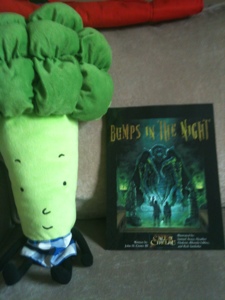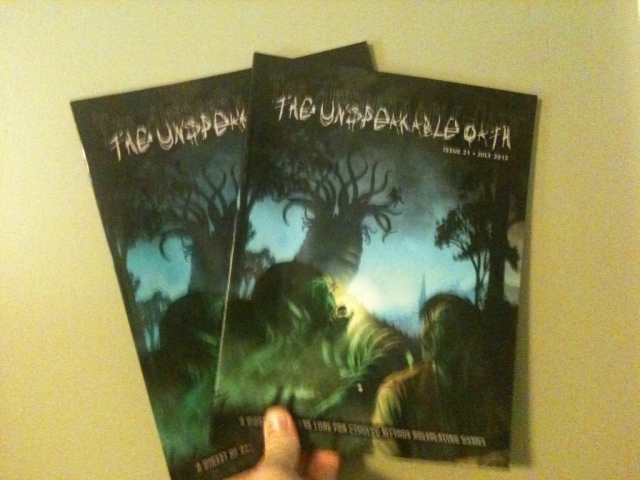Sorry for the lack of updates of late; I’ve been rather busy unfortunately. Fear not, I’ll return soon with pictures of Hecubus, graveyard tales, and new books to discuss soon.
Monthly Archives: September 2012
Unspeakable Oath #21 arrives
Oooh, shiny
We’ve had some nice developments in the land of Cthulhu. Aside from my receipt of Bumps in the Night a couple days back, I’ve also had an update from Dennis Detwiller regarding The Sense of the Sleight of Hand Mancampaign (including a little preview, woooo) Kickstarter project. Looks to be shaping up very well.
Finally, Shane Ivey has posted the audio recording of the Delta Green seminar at GenCon this year. Give it a listen, here.
Outside of gaming, I have also learned a bit more about a more obscure burial site in Worcester County, this time the Baptist Church at Harvard at Still River. Looks like one of the stones is legit (or the late Deacon William Willard, d. 1793) but the other two are discarded stones found in secondary use near to the church. My thanks to the Harvard Historical Society for the information. (Oh, and I’ve finished a preliminary survey of Middlesex Co. graveyards on my Graveyards page; Norfolk County is up next.)
All that, plus it is once again apple picking season here in Lovecraft Country so I’m happily saited with cider and fine varietals. Yum.
A bump at the door

Happily the postman brought my copy of Bumps in the Night in the post today. Huzzah! More later, once I’ve read it.
Young and Felton, carvers
As a side project I’ve plotted out the rough (very rough) distribution of stones carved by two of my favorite gravestone carvers, William Young (aka the Thistle-Carver of Tatnuck) and the Ebenezer Felton. I’d like to include notes about identifying carvers in my graveyards book, so I figure I’d better learn to identify them myself first. I like these particular carvers because they are idiosyncratic. Young’s work is amateurish, irregular, and has a very personal touch. Felton, while being more regular, is very different than almost any stones I’ve encountered (though the Sikes family shares some similar qualities). Out of curiosity I plotted out what cemeteries – roughly – that these carvers have stones at. For a start I used the Farber collection, since it is easy to search and sort, though I have made some additions based on my research. The photos are taken from Farber, since my files are currently buried in my office.
Here is a sample stone by Young:  As you can see, the human head is very crudely rendered, almost abstract. Still, I find it charming.
As you can see, the human head is very crudely rendered, almost abstract. Still, I find it charming.
Probably the best source on Young is Forbes’ Gravestones of Early New England and the Men Who Made Them though she was writing in 1928; there is also a good profile in Markers #4 starting on p. 138. See the complete set of Farber images here.
Here is his map.
As for Mr. Felton, here is a sample: Wacky, no? Flying hair, mouthless face, almost like an alien.
Wacky, no? Flying hair, mouthless face, almost like an alien.
The best source for Felton is a short piece in Markers #4, p. 169; here is the Farber images for Felton.
Here is the Felton map:
